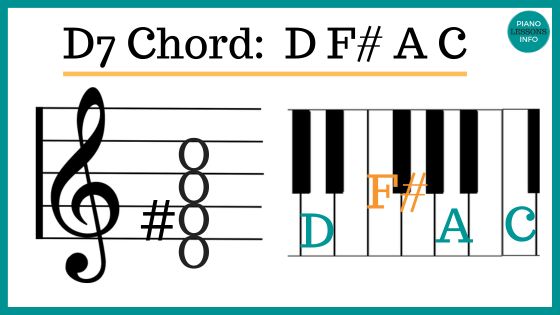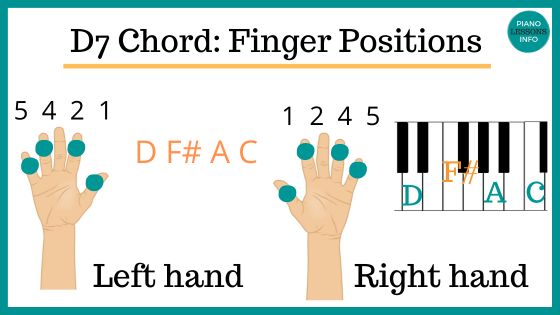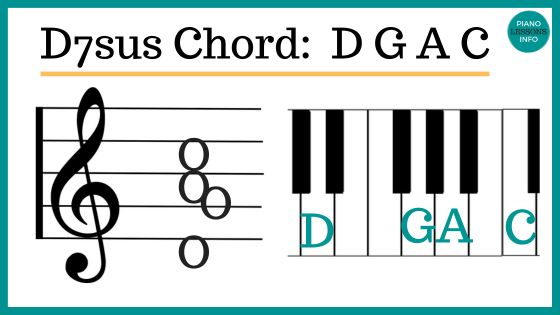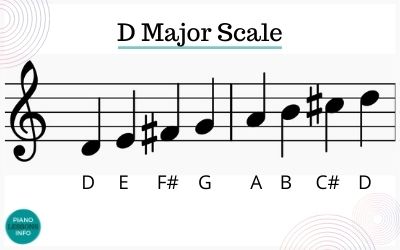D7 Piano Chord Notes, Variations & How To Play It
(D Seventh Chord)
The D7 piano chord is a great one to learn and quite important for you to get under your belt. This one definitely comes up a lot!
So here, we'll cover what the D7 chord is and how to play it on piano as well as:
- D7 piano chord notes
- D7 finger positions
- chords progressions using D7
- D7sus4 piano chord notes
- and how to understand D7 in terms of theory
D7 Piano Chord Notes
The notes of the D7 chord are: D F# A C.
This is basically the D chord with the addition of the C at the top.
D7 is a seventh chord and contains no "m," "M" or "maj" in the chord title. Just a 7 with the possible addition of a sharp or flat.
Here are the notes of the D7 chord on the treble clef and the piano keys:

How to Play Video and Sound
This video will show you how to play the D7 chord on piano:
As you can see, this is a 4 note chord and some find those tricky to play in the beginning. But your hand will adjust.
Finger Positions for D7 Piano Chord
The D7 piano chord is a 4 note chord and if you're playing it in root position, it's a good idea to use these finger positions or fingering:
Right hand fingers: 1, 2, 4, 5
Left hand fingers: 5, 4, 2, 1
This means every finger but the middle finger when playing in root position.

D7sus4 Piano Chord
Another type of D7 chord that is useful to know is the suspended 7th chord - in this case it's D7sus4.
It looks complicated but means this:
Start with the D7 chord: D F# A C
Next, make it suspended (sus / 4): change F# to G
The notes of D7sus4 or D7sus are D G A C.

D7 Chord Progression
Now that you know the notes of the D7 chord it's a good idea to practice is. Here are some chord progressions you can use to practice getting into and out of this chord. Start by playing the chord in root position and then once this becomes easier, experiment with trying it in different inversions.
D7 Chord Progression 1:
G Am7 D7 C
D7 Chord Progression 2:
D7 Bm7 Em7 A
D7 Chord Progression 3:
G C D7sus D G
How Do You Make A D7 Chord (Chord Theory)
Understanding how seventh chords are made is really useful because it means you can figure them out of your own.
To do this we need the D major scale:

The formula for a 7th chord is the first, third, fifth and lowered seventh notes of the major scale.
7th chord formula: 1, 3, 5, b7
So, in looking at the scale above, for D we have:
1 - D
3 - F#
5 - A
b7 - C (C# is in the key signature and we need to lower that to C for this chord).
Remember, lowering a note means that we go down one semi-tone. So a sharp becomes a natural and a natural becomes flat - like in C7.
You can learn more about 7th chords here.
If you need more help understanding key signatures, visit the key signatures page.
If you need to look up more chords, visit the Piano Chord Charts page or download your own copy below.
Free Download:
Ultimate Chord Cheat Sheet

Subscribe below and get free access to the (printable) Ultimate Chord Cheat Sheet.
Recent Articles
-
Piano Notes Chart
Nov 20, 23 10:21 PM
Find a piano notes chart for treble clef and bass clef notes as well as the different types of notes. -
D Chord on Piano + Diagram, How To & Theory
Oct 24, 23 12:20 AM
Learn how to play the D chord on piano with diagram, fingering, D/A, D/F# and a theory explainer. -
Diminished Piano Chords: Chart & How to Make Them
Oct 09, 23 09:23 PM
Learn the different diminished piano chords and how to make them. Here you'll find both a diminished chord chart and an explanation.
- Home
- 14 Day Chord Challenge
- D7 Piano Chord
Free Download:
Ultimate Chord Cheat Sheet

Subscribe below and get free access to the (printable) Ultimate Chord Cheat Sheet.
















